

SOA Manifesto. SOA Manifesto.
Pièges du SOA. What Makes SOA Different?- Page 2. SCA. Application silos. SOA against the World. SOA Evolution. The evolution of SOA. The Evolution of SOA. Microservices. Enterprise Integration Patterns - Table of Contents. SOA : Du composant au service : La découvrabilité. Comme son nom le suggère, l’élément clé de SOA (Service Oriented Architecture) est le Service.
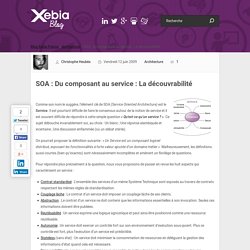
Il est pourtant difficile de faire le consensus autour de la notion de service et il est souvent difficile de répondre à cette simple question « Qu’est-ce qu’un service ? ». Ce sujet débouche invariablement sur, au choix : Un blanc ; Une réponse alambiquée et incertaine ; Une discussion enflammée (ou un débat stérile). On pourrait proposer la définition suivante : « Un Service est un composant logiciel distribué, exposant les fonctionnalités à forte valeur ajoutée d’un domaine métier ». Malheureusement, les définitions aussi courtes (bien qu’exactes) sont nécessairement incomplètes et amènent un florilège de questions. Pour répondre plus précisément à la question, nous vous proposons de passer en revue les huit aspects qui caractérisent un service :
SOA - 3ème édition - Le guide de l'architecte d'un SI agile: Le guide de l ... - Xavier Fournier-Morel, Pascal Grojean, Guillaume Plouin, Cyril Rognon. Livre%20blanc-SOA%20Architecture%20Logique.pdf. SOA Manifesto. Service-Oriented Architecture and Legacy Systems. This article first appeared in IEEE Software magazine.
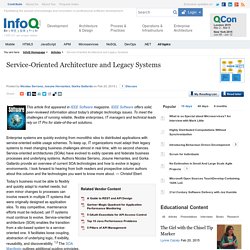
IEEE Software offers solid, peer-reviewed information about today's strategic technology issues. To meet the challenges of running reliable, flexible enterprises, IT managers and technical leads rely on IT Pro for state-of-the-art solutions. Enterprise systems are quickly evolving from monolithic silos to distributed applications with service-oriented exible usage schemes.
To keep up, IT organizations must adapt their legacy systems to meet changing business challenges almost in real time, with no second chances. Service-oriented architectures (SOAs) have evolved to exibly operate and federate business processes and underlying systems. Today’s business must be able to flexibly and quickly adapt to market needs, but even minor changes to processes can involve rework in multiple IT systems that were originally designed as application silos. SOA - Architecture Orientée Service : Démystification. SOA - Architecture Orientée Service. Décembre 2017.

Oracle E-Business Suite Integrated SOA Gateway User's Guide. Browser version script Skip Headers Service Enablement Overview.
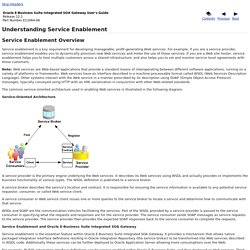
COLLECTIONS Service Oriented Architecture - Shaw Systems Associates, Inc. The collections products provide a clear positive advantage because they are built on a service-oriented architecture (SOA) where business functions are exposed.
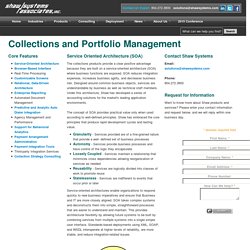
SOA reduces integration expenses, increases business agility, and decreases business risk. Designed around common business objects, services are understandable by business as well as technical staff members. Under this architecture, Shaw has developed a series of accounting solutions for the market's leading application environments. Service Oriented Architecture. Service-orientation.
Service-orientation has received a lot of attention since 2005 [4] due to the benefits it promises.

These include increased return on investment, organisational agility and interoperability as well as a better alignment between business and IT. It builds heavily on earlier design paradigms and enhances them with standardisation, loose coupling and business involvement.[5] History of service-orientation principles and tenets[edit] In technology, different vendor SOA platforms have used different definitions of service-orientation. Some vendors promote different principles and tenets over others, but a fair amount of commonality exists.[6]
Architectural pattern. Definition[edit] Even though an architectural pattern conveys an image of a system, it is not an architecture.

An architectural pattern is a concept that solves and delineates some essential cohesive elements of a software architecture. Countless different architectures may implement the same pattern and share the related characteristics. Patterns are often defined as "strictly described and commonly available".[2][3] For example, the layered architecture is a call-and-return style because it defines an overall style to interact. When it is strictly described and commonly available, it is a pattern. Paradigme. Un article de Wikipédia, l'encyclopédie libre. Universum, C. Design pattern. A design pattern in architecture and computer science is a formal way of documenting a solution to a design problem in a particular field of expertise.
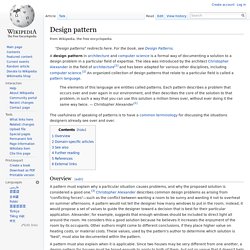
The idea was introduced by the architect Christopher Alexander in the field of architecture[1] and has been adapted for various other disciplines, including computer science.[2] An organized collection of design patterns that relate to a particular field is called a pattern language. The elements of this language are entities called patterns. Each pattern describes a problem that occurs over and over again in our environment, and then describes the core of the solution to that problem, in such a way that you can use this solution a million times over, without ever doing it the same way twice. — Christopher Alexander[1] Service-orientation. SOA (Service Oriented Architecture) Definition. Stands for "Service Oriented Architecture.

" When businesses grow, they often add new products and services. While these additions may help make the business larger, it is often difficult to implement them in an efficient manner. The goal of SOA is to make it easy for businesses to grow and add new services. Separation of concerns. The value of separation of concerns is simplifying development and maintenance of computer programs.
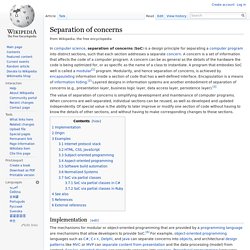
When concerns are well-separated, individual sections can be reused, as well as developed and updated independently. Of special value is the ability to later improve or modify one section of code without having to know the details of other sections, and without having to make corresponding changes to those sections. Implementation[edit] Separation of concerns is an important design principle in many other areas as well, such as urban planning, architecture and information design.[5] The goal is to more effectively understand, design, and manage complex interdependent systems, so that functions can be reused, optimized independently of other functions, and insulated from the potential failure of other functions. Modular programming. "Code Factoring" redirects here. It is not to be confused with code refactoring.
Modular programming is a software design technique that emphasizes separating the functionality of a program into independent, interchangeable modules, such that each contains everything necessary to execute only one aspect of the desired functionality.[1] Separation of concerns. Software architecture. Software architecture is the high level structure of a software system, the discipline of creating such structures, and the documentation of these structures.
It is the set of structures needed to reason about the software system, and comprises the software elements, the relations between them, and the properties of both elements and relations.[1] The architecture of a software system is a metaphor, analogous to the architecture of a building.[2] Software architecture choices include specific structural options from possibilities in the design of software. For example, the systems that controlled the space shuttle launch vehicle have the requirement of being very fast, and very reliable, in principle. SOA_EDA_Part_1.pdf. "BPM et SOA : une forte complémentarité", une tribune de Phil Gilbert, Lombardi. Business Process Management. Un article de Wikipédia, l'encyclopédie libre. Pour les articles homonymes, voir BPM. Le Business Process Management (BPM), ou Gestion des Processus Métiers[1], permet d’avoir une vue d’ensemble de processus métiers[2] de l’organisation et de leurs interactions pour les optimiser et les automatiser autant que possible.
Pour ce faire, il faut analyser le fonctionnement réel de l'entreprise afin de le modéliser informatiquement, par exemple avec le formalisme BPMN et les outils associés. Dans une deuxième étape, les processus automatisés, même partiellement, font l'objet d'un monitoring (Cf. Business Activity Monitoring) qui permet d'identifier les restructurations à entreprendre. Les objectifs du BPM sont d‘apporter à l’organisation une valeur supplémentaire en améliorant sa performance[3], sa productivité et une qualité du service au client.
Complex Event Processing and SOA: a 'beautiful thing'? The drums keep beating louder for the impending marriage of SOA with Event Driven Architecture and Complex Event Processing. This is top of the news for many analysts, and something IBM, Oracle, and other vendors are positioning future offerings around. Is this the year when organizations will start linking SOA efforts closely to real-time processes? Are we ready to link SOA with real-time processing? CEP and SOA: Six Letters Are Better than Three. Service-Oriented Architecture (SOA) If you establish more data integration by using ODS and MDM data stores, you also need a messaging, or communication, architecture to enable systems that weren’t built to communicate with each other to do so. Enter the concept of service-oriented architectures, or SOAs.
SOA is a method for systems development and integration in which functionality is grouped around business processes and packaged as interoperable services. SOA also describes IT infrastructure that allows different applications to exchange data with one another while they participate in business processes.
An SOA aims to loosely couple services with operating systems, programming languages, and other technologies that underlie applications. This process is very similar to what happened with audio visual equipment while it evolved. These services communicate with each other by passing data from one service to another, or by coordinating an activity between two or more services. SOA - Architecture Orientée Service. Component-based software engineering.
An example of two components expressed in UML 2.0. The checkout component, responsible for facilitating the customer's order, requires the card processing component to charge the customer's credit/debit card (functionality that the latter provides). Component-based software engineering (CBSE) (also known as component-based development (CBD)) is a branch of software engineering that emphasizes the separation of concerns in respect of the wide-ranging functionality available throughout a given software system. It is a reuse-based approach to defining, implementing and composing loosely coupled independent components into systems. This practice aims to bring about an equally wide-ranging degree of benefits in both the short-term and the long-term for the software itself and for organizations that sponsor such software. Service Component Architecture.
Un article de Wikipédia, l'encyclopédie libre. Pour les articles homonymes, voir SCA. SOAP. Un article de Wikipédia, l'encyclopédie libre. Pour l’article homophone, voir S.O.A.P.. Web Services Description Language. Remote procedure call. Enterprise service bus. Web-oriented architecture. Masquage de l'information. Un article de Wikipédia, l'encyclopédie libre. Indépendance fonctionnelle. Un article de Wikipédia, l'encyclopédie libre. Format ouvert. Un article de Wikipédia, l'encyclopédie libre. Les termes format ouvert, format libre[1],[2] ou encore spécification ouverte, désignent des formats de données interopérables et dont les spécifications techniques sont publiques et sans restriction d’accès ni de mise en œuvre, par opposition à un format fermé ou propriétaire.
Interopérabilité en informatique. Interface de programmation. Interface. Cohésion (informatique) Architecture en flot de données. Architecture orientée services.